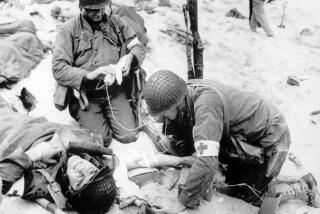Milestones in Cardiac Care
- Share via
DEATHS FROM HEART disease in America peaked in 1965, the same year that cardiologists agree was pivotal in treating heart patients. “The mid-’60s are when we actually turned the corner,” says Dr. David Cannom, a clinical cardiology professor at the UCLA School of Medicine. “Cardiac catheterization and valvular surgery were in place, and we were beginning to know what to expect when looking at a heart patient.” And though life-style changes have helped reduce heart attacks, advances in surgery and medicine have played an important role as well. “We got to the point in the early ‘70s where we were able to be aggressive in our treatments instead of being solely diagnosticians,” says Dr. Jan Tillisch, director of the UCLA cardiac care unit. “There was a change in attitude and a confidence in procedures and new medicine.”
Cardiac-care milestones in the past 50 years have increased the life-extending options for the 65 million Americans who will suffer from heart disease this year.
1938: Surgeons repair an undeveloped fetal vessel, a common defect.
Early 1940s: Hypertension is reduced surgically. (The anti-hypertensive drug guanethidine replaces this procedure in 1948.)
1951: Cardiac output, the amount of blood pumped by the heart per minute, is measured in patients with coronary shock.
1952: An externally powered pacemaker is implanted, artificially controlling the heartbeat through electrical discharges.
1954: Surgeons at Peter Bent Brigham Hospital in Boston perform a successful kidney transplant between identical twins. Six years later, doctors successfully transplant a kidney between non-identical twins.
1955: By oxygenating and pumping blood, the heart-lung machine allows for open heart surgery.
1957: Closed-chest defibrillator is used on patients in cardiac arrest.
1960: Stainless-steel valves are used to replace damaged heart valves.
Early 1960s: Immunosuppressive drugs are developed, preventing rejection of transplanted organs.
1966: Isoproterenol is developed; it improves blood flow in patients with heart failure.
Dec. 3, 1967: In Cape Town, South Africa, Dr. Christiaan Barnard performs the first heart transplant. Patient Louis Washkansky, 55, lives 18 days.
1967: Coronary artery bypass surgery is first performed.
Jan. 6, 1968: At Stanford University Medical Center, Dr. Norman Shumway performs the first successful heart transplant operation in the United States on Mike Kasperak, 54, who lives 14 days.
Mid-1970s: Cryocardioplegia, in which donor hearts are preserved for shipment in iced saline solution, is developed, allowing hospitals to accept hearts from greater distances.
1979: Experimental use of cyclosporine begins in the United States. It dramatically increases a recipient’s ability to overcome rejection. (In 1983, it is accepted for use by the FDA.)
Dec. 2, 1982: Dr. William De Vries at the University of Utah Medical Center implants the first artificial heart, the Jarvik-7, in retired dentist Barney Clark, 61. He lives 112 days.
Oct. 26, 1984: Dr. Leonard Bailey at Loma Linda University Medical Center in Loma Linda implants the heart of a baboon into Baby Fae, who dies after 20 days.
January, 1986: The California Legislature enacts the “required request” law, ordering hospitals to ask relatives of a patient declared brain-dead to donate the deceased’s organs.




